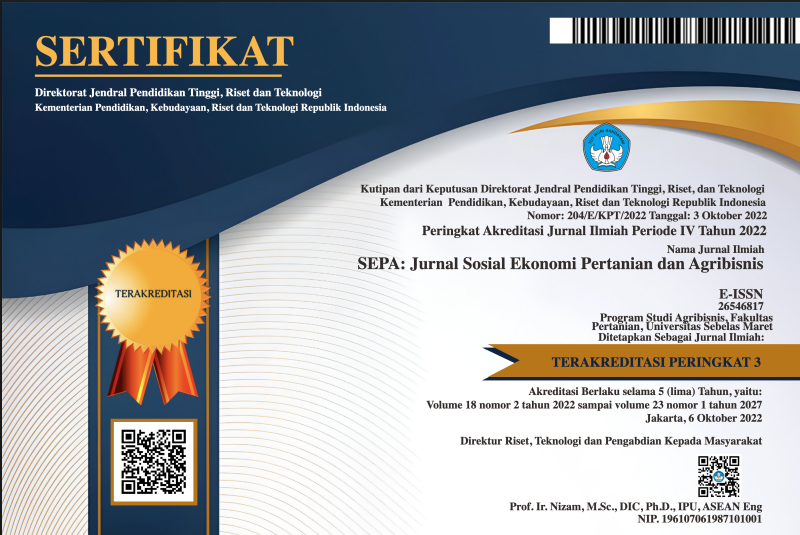RESPON PENAWARAN PETANI BAWANG PUTIH DI TENGAH PANDEMI COVID-19
Abstract
Keywords
Full Text:
PDFReferences
Agustian, A., & Hartoyo, S. (2012). Pendugaan elastisitas penawaran output dan permintaan input usahatani jagung. Jurnal Ekonomi Pembangunan, 13(2), 247–259.
Ajija, S., Setianto, D., Setianto, R., & Primanti, M. (2012). Cara Cerdas Menguasai Eviews. Jakarta: Salemba Empat.
Amine M. Benmehaia. (2021). Aggregate supply response in Algerian agriculture: the error correction model applied to selected crops. New Medit, 20(1), 85–96. https://doi.org/10.30682/nm2101f.
Awotide, D. O. (2012). Supply response of maize, millet and sorghum in nigeria: an error correction model approach. Nigerian Journal of Agricultural Economics (NJAE), 3(1), 19–27.
Blanc, E. (2013). Food crop supply in sub-saharan africa and climate change. Journal of Development and Agricultural Economics, 5(9), 337–350.
Guo, F., Liu, P., Zhang, C., Chen, W., Han, W., Ren, W., & Ding, J. (2019). Research on the law of garlic price based on big data. Computers, Materials and Continua, 58(3), 795–808. https://doi.org/10.32604/ cmc.2019.03795.
Hariwibowo, P. A., Anindita, R., & Suhartini. (2014). Penawaran bawang putih di indonesia. AGRIMETA: Jurnal Pertanian Berbasis Keseimbangan Ekosistem, 4(8), 1262–1265.
Hariwibowo, P. A., Anindita, R., & Suhartini, S. (2015). The evaluation of indonesia import policies of garlic. Greener Journal of Business and Management Studies, 5(1), 016–030. https://doi.org/ 10.15580/gjbms.2015.1.081414329.
Ibitoye, S. J., & Shaibu, U. M. (2014). The effect of rainfall and temperature on maize yields in Kogi State, Nigeria. Asian Journal of Basic and Applied Sciences, 1(2), 37–43. https://doi.org/ 10.2307/1229773.
Kareem, R., Ayinde, I., Bakare H.A, & Bashir, N. (2014). Determinants of aggregate agricultural supply response in Nigeria. Nigerian Journal of Agricultural Economics (NJAE), 4(1), 44–57.
Leaver, R. (2004). Measuring the supply response function of tobacco in Zimbabwe. Agrekon, 43(1), 114–131.
Madlul, N. S., Bakar, R., & Lubis, Z. (2017). The influence of price and non-price factors on maize supply in Iraq: An econometrical analysis. Imperial Journal of Interdisciplinary Research (IJIR), 3(7), 592–605. https:// doi.org/10.32861/jac.53.38.42.
Magfiroh, I. S., Zainuddin, A., & Setyawati, I. K. (2018). Maize supply response in Indonesia. Buletin Ilmiah Litbang Perdagangan, 12(1), 47–72.
Nerlove, M. (1956). Estimates of the elasticities of supply selected agricultural commodities. Journal Farm Econ, 38(2), 496–506.
Oladejo, J. A., & Ladipo, O. O. (2012). Supply analysis for maize in Oyo and Osun States of Nigeria. International Journal of Life Science & Pharma Research, 2(2), 8–18. Retrieved from http://ijlpr.com/admin/php/uploads/60_pdf.pdf
Onono, P. A., Wawire, N. W. H., & Ombuki, C. (2013). The response of maize production in Kenya to economic incentives. International Journal of Development and Sustainability, 2(2), 530–543.
Pangestika, V. B., Syafrial, & Suhartini. (2015). Terhadap kinerja ekonomi jagung di Indonesia the simulation of corn import tarif policy toward the productivity of corn economy in Indonesia. Habitat, 26(2), 100–107.
Siregar, G. S. (2009). Analisis respon penawaran jagung dalam rangka mencapai swasembada jagung di Indonesia [Skripsi]. Institut Pertanian Bogor, Bogor.
Sitinjak, W. (2015). Analisis faktor-faktor yang memengaruhi permintaan dan penawaran jagung di Provinsi Sumatera Utara [Skripsi]. Universitas Sumatera Utara, Medan.
Suryani, E., Hartoyo, S., Sinaga, B. M., & Sumaryanto, N. (2015). Pendugaan elastisitas penawaran output dan permintaan input pada usaha tani padi dan jagung: pendekatan multiinput-multioutput. Jurnal Agro Ekonomi, 33(2), 91–106. https://doi.org/10.21082/ jae.v33n2.2015.91-106.
Usman, B. A., Adefila, J. O., & Musa, I. J. (2013). Impact of rural road transport on agricultural production in Kwara State , Nigeria. Nigerian Journal of Agriculture, Food and Environment, 9(2), 20–25.
Widarjono, A. (2012). Ekonometrika Pengantar dan Aplikasinya. Yogyakarta: Ekonisia.
DOI: https://doi.org/10.20961/sepa.v19i1.53148
Refbacks
- There are currently no refbacks.



.png)







.png)
3.png)





